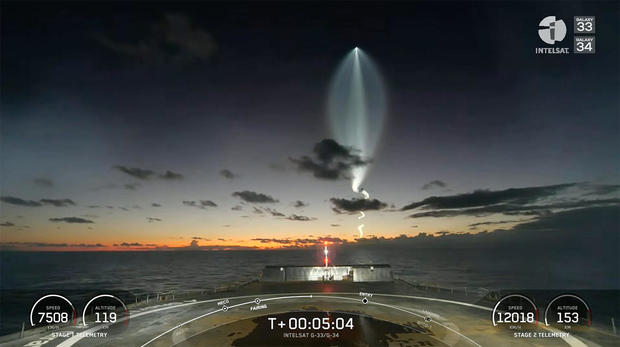SpaceX Falcon 9 puts on spectacular sunset sky show boosting 2 Intelsat satellites to orbit
Running two days late after back-to-back scrubs, SpaceX launched a pair of Intelsat communications satellites from Cape Canaveral Saturday evening in the company's third Falcon 9 launch in as many days. It followed two flights Wednesday, one from each coast, that were just seven hours apart.
Using a first stage making its 14th flight — the most yet for a non-SpaceX commercial customer — the latest Falcon 9 blasted off from the Cape Canaveral Space Force Station at 7:05 p.m. EDT and climbed away on a due-east trajectory over the Atlantic Ocean.
After dropping off the well-used first stage for recovery on a SpaceX landing barge, the rocket's upper stage propelled the two-satellite payload out of the discernible atmosphere, and released them into elliptical "transfer" orbits, as planned, about 40 minutes after launch.
Spectacular video from the SpaceX droneship — awaiting the first stage several hundred miles down range in the Atlantic Ocean — showed the rocket's second stage exhaust plume dramatically expanding in the low-pressure upper atmosphere, an eye-catching effect best seen when backlit at dawn or sunset.
Area residents, tourists and photographers, amateur and professional alike, tweeted equally spectacular views of the rocket, silhouetted in front of the rising full moon as it raced toward orbit.
"Captured Falcon 9 with Intelsat Galaxy 33 & 34 transiting the full Hunter's Moon tonight from the waters of Florida's Indian River," tweeted photographer Trevor Mahlmann."
In any case, with a successful launch behind them, Intelsat's Galaxy 33 and 34 satellites will use on-board propulsion to raise the low and high points of their orbits until both reach circular "geosynchronous" altitudes, 22,300 miles above the equator, in direct line of sight to North America.
The satellites are the latest in an FCC-mandated drive to free up space in the radio spectrum for 5G mobile networks, requiring new satellites to replace lost capacity. Galaxy 33 and 34 will be used by a variety of major media outlets, including HBO, the Disney channel, Starz and the Discovery channel.
"They're part of a seven-satellite buy that we did in 2020 to replace some of our Galaxy satellites," Jean-Luc Froeliger, senior vice president of space systems at Intelsat, told Spaceflight Now.
"Galaxy" is a brand name for Intelsat relay stations serving North America. The new satellites are being launched in pairs, with four more flights planned before the end of the year. That includes two from Cape Canaveral, Florida, using another Falcon 9, and two from French Guiana, using a European Ariane rocket.
The seventh Galaxy is heavier than the others and will be launched by itself in the first half of 2023.


